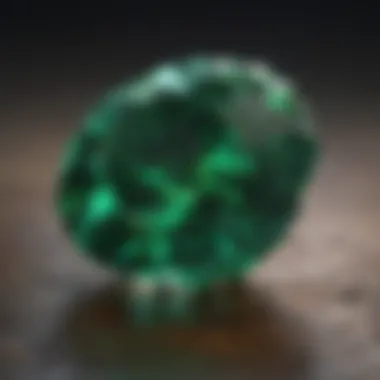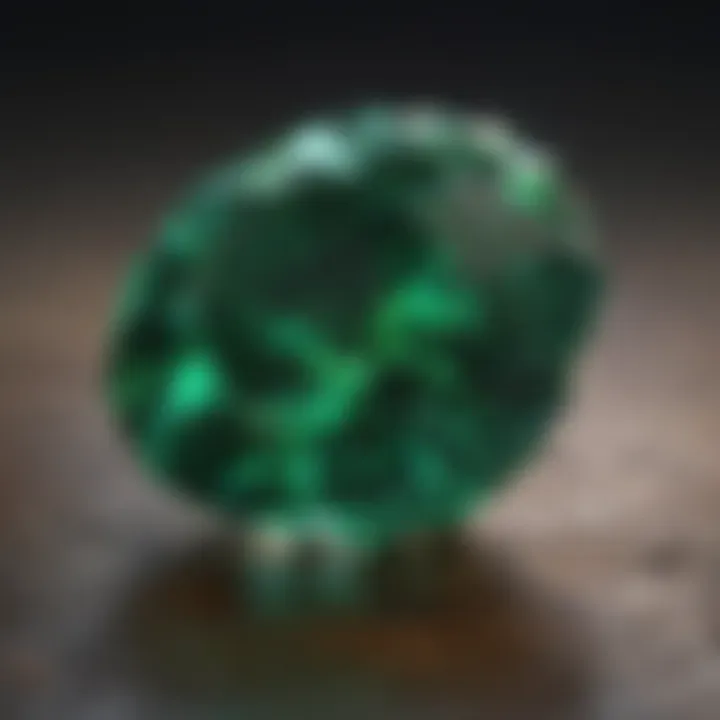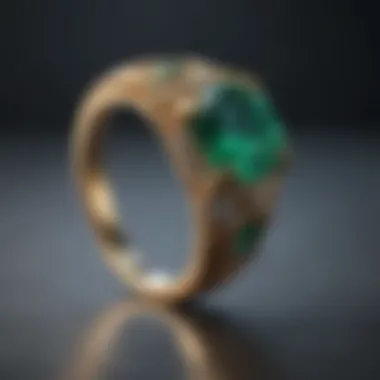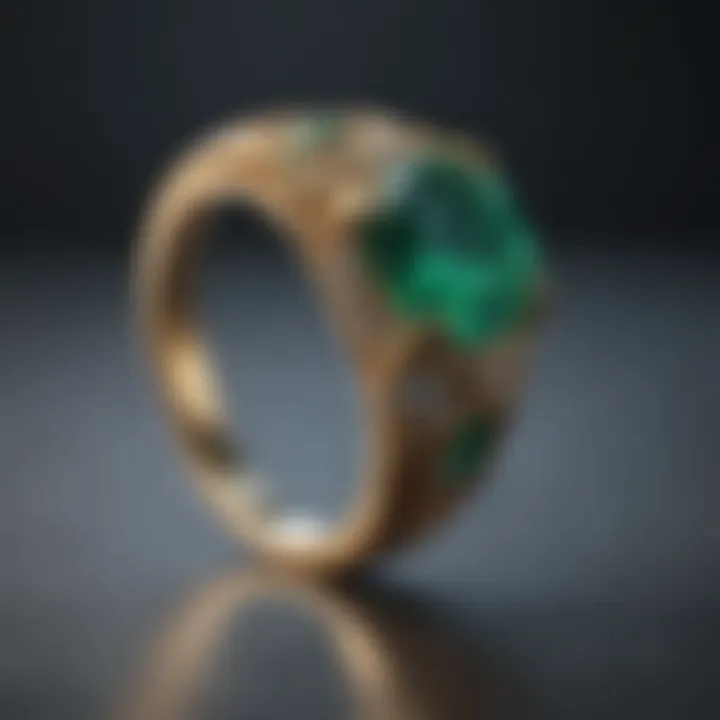The Birthstone of May: Color and Cultural Significance


Intro
The emerald, characterized by its mesmerizing green hue, captivates many gemstone enthusiasts and collectors. This gemstone holds a significant position in various cultures and is revered for its vibrant color and rich history. Understanding the emerald entails delving into its properties, historical significance, and its implications for individuals born in May. As we navigate through the details of this splendid gem, we will uncover the color that defines its allure and the cultural narratives that surround it.
Gemstone Overview
Definition of Gemstones
Gemstones are precious or semi-precious materials that are often cut and polished for use in jewelry, decorative objects, and various adornments. They are valued for their beauty, rarity, and durability. Each gemstone possesses unique properties, forming a vast array of colors and types. In the context of May, the emerald stands out, showcasing a distinct green color that is both enchanting and historically significant.
Classification of Gemstones
Gemstones can be broadly classified into two categories: precious and semi-precious. Precious gemstones include diamonds, sapphires, rubies, and emeralds. Semi-precious stones encompass a wider variety of materials, such as amethysts and garnets. The emerald finds itself within the rare category of precious gemstones, known for its deep color and clarity. The classification also extends to the origin of the stones, with natural, synthetic, and treated materials being common classifications. Natural emeralds are formed through geological processes over millions of years, while synthetic and treated stones are created or enhanced through human intervention.
Historical Significance
Origins of Gemstone Use
The use of gemstones can be traced back to ancient civilizations, where they often held symbolic meanings and were attributed with various powers. The emerald, in particular, has a storied past, making its mark in different cultures throughout history. It has been worn by countless rulers and was believed to possess the ability to grant wisdom and protect its wearer.
Cultural Insights: Gemstones in Ancient Civilizations
In ancient Egypt, emeralds were highly regarded, often associated with fertility and rebirth. Cleopatra, the Queen of Egypt, was known for her fondness for emeralds, which further solidified their status in society.
In other cultures, emeralds were said to protect against evil spirits and provide insight into the truth. They were utilized in art, jewelry, and even medicinal practices.
"Emeralds have been more than just gems; they are symbols of power, love, and wisdom throughout history."
The cultural importance of emeralds persists today, extending into contemporary jewelry design where these gems continue to be celebrated for their extraordinary qualities.
Understanding Birthstones
The concept of birthstones hails from ancient traditions, where each month of the year corresponds to a specific gemstone. This practice not only serves aesthetic purposes but also reflects deeper meanings and various beliefs tied to each stone. Birthstones are often seen as gifts, carrying significance and charm that can bring good luck or protection to the wearer. For May, the emerald reigns supreme, representing a unique blend of beauty and historical weight.
Definition and History
Birthstones are gemstones that represent the month of a person's birth. Each stone is imbued with attributes believed to influence the individual associated with it. The tradition of assigning gemstones to specific months can be traced back to ancient cultures, notably the Israelites in the biblical times. They wore a breastplate adorned with twelve stones, symbolizing the twelve tribes of Israel. Over the centuries, this notion evolved into the modern list of birthstones that we recognize today.
The emerald, as the birthstone for May, boasts a lineage rich in mythology and reverence. Historically, this stone has captivated civilizations from the Egyptians, who associated it with fertility and rebirth, to the ancient Romans, who prized it as a symbol of love and success. The deep green color of emeralds evokes a sense of life and vibrancy, making it an eternal favorite.
Cultural Significance
Different cultures assign various meanings to birthstones. Emeralds, for instance, have significant representation across multiple societies. In many cultures, emeralds symbolize wisdom, growth, and patience. They are regarded as protective stones, believed to ward off negative energies and enhance the clarity of thoughts.
In ancient Egypt, emeralds were closely linked with the goddess Isis, associated with fertility and motherhood. This connection solidified its status, making it a powerful stone among royalty. Similarly, in ancient Rome, wearing emeralds was considered a sign of success. The stone's rich green hue is often associated with nature and renewal, highlighting its relevance in cultural rituals and celebrations.
Modern Interpretations
In contemporary settings, birthstones like the emerald are appreciated not only for their historical and cultural significance but also for their aesthetic value. Nowadays, many individuals choose to wear their birthstones, not just for their meanings but also as a fashion statement. The emerald, recognized for its vibrant color, has found a place in modern jewelry design.
Emeralds are frequently incorporated into rings, necklaces, and bracelets, appealing to gemstone enthusiasts and collectors alike. The intriguing blend of tradition and modernity allows for varied interpretations of what it means to wear a birthstone. Some individuals wear their birthstones to symbolize their identity, while for others, it is a matter of personal style or emotional connection.
In summary, understanding birthstones offers insight into the cultural and historical contexts surrounding these unique gems. The emerald, as May's birthstone, stands out due to its rich history, profound symbolism, and continued relevance in contemporary society. Its journey through time highlights not only its beauty but also its role in shaping personal narratives.
The May Birthstone: An Overview


The significance of the May birthstone, the emerald, extends beyond simple beauty. This section aims to provide a clear understanding of emeralds, focusing on their intrinsic properties and the cultural weight they carry. Insight into emeralds reveals why they are regarded as a symbol of renewal and vibrancy, touching on their essential characteristics and historical context.
Preface to Emeralds
Emeralds are a type of beryl that are well known for their lush green color. This gemstone is unique among other stones because of its rich history and the various associations people have built around it. Believed to represent hope and growth, emeralds often symbolize rebirth. The green hue can evoke thoughts of nature and life, which resonates particularly with those born in May. Ancient texts often mention the significance of emeralds, making them an enduring part of human culture and heritage.
Properties of Emeralds
Emeralds exhibit a few notable properties that set them apart from other gemstones. For starters, they have a high refractive index, which gives them their sparkling quality. This effect makes them appealing to gem enthusiasts and collectors. In terms of hardness, emeralds are somewhat more fragile than diamonds, rated around 7.5 to 8 on the Mohs scale. Therefore, while they are durable, they require careful handling to avoid damage.
Emeralds are often treated to enhance clarity and color, which impacts their value significantly.
Another essential aspect is their clarity. Unlike other gemstones, many emeralds show inclusions, known as "jardin," that can actually add character. This distinct attribute influences the overall aesthetic and market valuation of the stone.
Emerald's Color Spectrum
The color of emeralds can vary widely, but the most sought-after shade is a deep, vivid green. Factors such as the presence of chromium and vanadium in the stone significantly affect its color. A perfectly pure and deeply colored emerald is rare and can command prices exceeding that of diamonds. Moreover, less intense shades of green, tending towards lighter hues or even blue-green, exist but are usually considered less valuable than their richer counterparts.
When evaluating emeralds, their color quality is paramount. The categorization can be divided into three main color quality factors:
- Hue: The basic color of the emerald, which typically falls within the green spectrum.
- Tone: The relative lightness or darkness of the color.
- Saturation: The intensity and vividness of the color.
Understanding these elements contributes to a broader appreciation of the emerald as May's birthstone, providing insight into its allure and timeless relevance.
Color Characteristics of Emeralds
Understanding the color characteristics of emeralds is integral to appreciating their allure and value. The emerald's unique green hues, ranging from light to deep, set it apart within the gemstone community. Identifying these colors allows connoisseurs and collectors to judge the stone’s quality and significance effectively. It is not merely the color itself that holds meaning; it also tells a story about its origin and treatment. This section examines the subcategories of emerald colors, focusing particularly on the various shades and their visual impact, along with clarity and overall quality. Both aspects are crucial, as they directly influence the desirability and market value of these gemstones.
Shades of Green
Emeralds are widely recognized for their vibrant green color. However, it is essential to recognize that this color manifests in several shades, each with its unique appeal.
- Light Green: Often associated with youth and freshness, light green emeralds bring a playful yet elegant touch to jewelry pieces. These stones can appear somewhat translucent, enhancing their delicacy.
- Medium Green: The most classic shade, medium green is often regarded as the ideal color for an emerald. It balances richness with brightness, contributing to its versatility in jewelry design.
- Dark Green: Deep green emeralds hold a sense of mystery and sophistication. However, they can sometimes exhibit inclusions that may affect their clarity negatively.
The color intensity often determines the gemstone's value. For instance, a vivid green emerald with fewer inclusions is often more sought after and can command a higher price. Not all green hues are created equal, and collectors often look for stones that exhibit a pure green tone without any brown or yellow overtones.
"The finest emeralds exhibit a deep, intense green, free from zoning, and possess a transparency that allows light to dance within it."
Clarity and Color Quality
The clarity of an emerald significantly impacts its overall color quality. Unlike many other gemstones, emeralds are often characterized by their inclusions, which are commonly referred to as "jardin." These internal features, while sometimes viewed as flaws, can lend a distinct personality to the stone. They serve both as identifiers of authenticity and markers of origin. However, clarity is crucial; stones with lower levels of inclusions often exhibit a more intense color, making them more desirable.
Emerald quality is typically rated based on color, clarity, and cut. Here’s how each factor ties into overall value:
- Color: As discussed, a vibrant, pure green is preferred.
- Clarity: Fewer inclusions generally lead to a higher value, although many collectors appreciate the"jardin" for its character.
- Cut: A well-cut emerald maximizes light entry, enhancing the perceived depth of color.
Significance of Emerald Color
The color of emeralds is a central aspect of their identity and allure. Renowned for their vibrant green hue, emeralds evoke various feelings and associations in different contexts. The significance of emerald color extends beyond mere aesthetics; it intertwines with cultural symbolism, emotional connections, and astrological influences.
Emerald green's rich, lush tone has a unique ability to captivate the observer. It is commonly associated with nature, growth, and rebirth. This strong connection to the earth enhances emeralds' value not just in terms of monetary worth but also in emotional and spiritual dimensions.
Symbolism in Various Cultures
Across many cultures, the emerald has held a special place due to its striking color and inherent beauty. For instance:


- Ancient Egyptians valued emeralds for their supposed powers of fertility and rebirth. They often adorned themselves with these gems, believing they would bring peace and balance.
- In India, emeralds are linked to the planet Mercury, which symbolizes intellect and wisdom. Here, they are thought to enhance the wearer’s mental clarity and communication skills.
- In the Islamic world, emeralds have been associated with paradise. The lush green color symbolizes serenity and a state of abundance.
Emeralds' color often represents concepts such as love, prosperity, and harmony. These associations make emeralds not only beautiful accessories but also deeply meaningful gifts, especially for individuals celebrating their birth month of May.
Astrological Associations
Astrology assigns particular significance to emeralds, especially for those born under the sign of Gemini, which spans from May 21 to June 20. In astrological terms, emeralds are believed to bring luck, love, and success to Geminis. The connection to Mercury infuses the stone with attributes of adaptability and eloquence, which are key traits for those born under this sign.
Many astrologers recommend wearing an emerald to balance the influence of Mercury. The idea is that it can enhance mental agility, reduce anxiety, and promote overall harmony in one’s life. Furthermore, its green color is thought to align with the heart chakra, encouraging emotional balance and compassion.
Emeralds are more than mere gemstones; their color and significance encapsulate stories and beliefs that span multiple cultures and generations.
Emerald in Historical Context
The historical significance of emeralds extends far beyond their aesthetic appeal. They have woven themselves into the fabric of various cultures, religions, and societies since ancient times. This section will explore how emeralds were perceived throughout history, their symbolic meanings, and their use by influential figures. Understanding these historical contexts enriches our appreciation of emeralds, making them more than a mere gemstone.
Ancient Civilizations and Beliefs
Emeralds have captured human fascination since antiquity. In ancient Egypt, they were associated with fertility and rebirth. Egyptian royalty often adorned themselves with emerald jewelry, believing it offered protection and enhanced their status. The goddess Isis was often depicted wearing emeralds, reinforcing their connection to divine powers. Notably, Cleopatra was known to be an ardent lover of emeralds, adoring their vibrant green and mystical qualities.
The ancient Greeks also held emeralds in high regard. They referred to the gemstone as 'smaragdos,' which translates to green stone. They believed that emeralds possessed healing powers, providing comfort and relieving diseases. The Greeks valued emeralds not just for beauty but for their therapeutic properties.
In Persia, emeralds were believed to provide foresight and were worn by leaders during important decisions. Similarly, in Indian culture, emeralds were thought to bring good luck and prosperity. They were often used in religious artifacts, enhancing their significance beyond mere decoration.
Notable Figures and Emeralds
Throughout history, many prominent figures have cherished emeralds, further solidifying their prestige. One such figure was the Mughal Emperor Akbar, who ruled in the 16th century. He famously amassed a considerable collection of emeralds, using them to embellish his throne and other royal regalia. His fondness for emeralds also extended to his military leaders, whom he gifted these exquisite stones as tokens of loyalty.
Additionally, emeralds have been significant in the world of fashion and jewelry design. Famous personalities, like the actress Elizabeth Taylor, were known to have a profound admiration for emeralds. Taylor often wore magnificent emerald pieces, drawing attention not only to their beauty but also to their historical and emotional resonance.
Another historical figure connected with emeralds is Pope Sixtus IV. He commissioned the creation of the famous "Emerald of Sixtus IV," an emerald cut in the shape of a cross. This emerald represented a melding of power and faith, signifying its importance in the religious domain.
"Emeralds are not just gemstones; they are tokens of history and story. Their presence in royal courts and among scholars shows their enduring allure."
In summary, emeralds have long been associated with power, beauty, and spirituality. Their significance across cultures and through different epochs demonstrates the enduring value attributed to this stunning gemstone. As we continue to explore emeralds, we will see how these historical threads contribute to their perception in modern contexts.
Emerald in Contemporary Jewelry
Emeralds hold a prominent place in today’s jewelry market. Their allure combines both historical significance and modern desirability. Today, the presence of emeralds in jewelry is not only about aesthetics but also about the underlying stories and meanings attached to these stunning gemstones. The May birthstone captivates collectors and designers alike by bridging the gap between tradition and contemporary trends.
Current Trends in Jewelry Design
The latest trends in jewelry design show a definite shift toward personal expression. Emeralds have carved out a niche in this movement, where custom and bespoke pieces become more prevalent. Designers often incorporate emeralds into unique structures, such as asymmetrical earrings or stacked rings. The combination of emeralds with various metals, including yellow gold and rose gold, enhances their green hue.
Another trend is the use of emeralds in combination with other gemstones. This practice creates vibrant contrasts and diverse styles. For instance, pairing emeralds with diamonds can showcase their rich green color against the brilliant sparkle of diamonds, creating an eye-catching effect. Statement pieces, such as bold cocktail rings adorned with emeralds, are gaining traction as people seek to make their jewelry distinctly personal. Furthermore, many contemporary jewelers are embracing sustainability, opting for ethically sourced emeralds in their collections, aligning with a growing consumer preference for responsible luxury.
Emerald's Role in Fashion
Emeralds are not just a part of jewelry; they have become a powerful fashion statement. They regularly appear on runways and red carpets, adorned by celebrities. Wearing emeralds signifies sophistication and opulence, thus marking their essential role in the fashion landscape. Green, universally favored for its lush and vibrant character, finds its way into seasonal palettes, especially in spring and summer collections. Many fashion designers choose to integrate emeralds in their accessories, while clothing designs often feature emerald tones.
The symbolism of emeralds further enhances their status in the fashion world. Associated with love, rebirth, and growth, they resonate with the values of many fashion brands that aim to inspire positivity and rejuvenation through their designs. The embracing of emeralds by high-profile influencers has categorized them as an essential gemstone, decorating pieces range from classic necklaces to avant-garde hair accessories and brooches.
Care and Maintenance of Emerald Jewelry
Emeralds, while durable, require a certain level of care due to their unique characteristics. Unlike diamonds, emeralds often contain inclusions that can affect their durability. It is essential to handle them with care to prevent scratches or damage. When cleaning emerald jewelry, using a gentle soap solution and a soft brush is advisable. Avoid harsh chemicals or ultrasonic cleaners, as these can harm the stone.


Storing emeralds carefully also matters. Use separate compartments to prevent scratches when placing them in a jewelry box. Additionally, wrapping emerald jewelry in soft cloth can protect it from elements that may cause wear. Regular professional cleaning is also recommended, ensuring that these gemstones retain their radiant beauty for years.
Emeralds, as the birthstone for May, represent not only luxurious adornment but also signify a deep connection to both culture and contemporary fashion. Thus, understanding their place in modern jewelry can significantly enhance the appreciation for this magnificent gemstone.
Value and Investment Potential
The value and investment potential of emeralds are critical aspects to consider when discussing May's birthstone. Emeralds are not only cherished for their aesthetic appeal but also appreciated for their ability to retain and possibly appreciate in value over time. Understanding what influences their value can assist collectors and investors in making informed decisions.
Factors Influencing Emerald Value
Several key elements determine the value of emeralds. These factors include:
- Color: The richness of green hue plays a significant role. Emeralds that exhibit pure, vivid green color with blue undertones are usually more valuable.
- Clarity: Unlike many other gemstones, emeralds often contain inclusions, commonly referred to as "jardin". Higher clarity, however, tends to result in higher value due to less visibility of these inclusions.
- Cut: The precision of the cut can affect the stone's brilliance and visual appeal. An expertly cut emerald can enhance its color and clarity aspects, increasing overall desirability.
- Carat Weight: Larger emeralds are rarer and therefore command higher prices. However, this value can vary depending on the quality of color and clarity as well.
- Origin: Emeralds from certain regions, such as Colombia, are often priced higher due to their historical significance and superior color quality.
Understanding these factors is essential for anyone looking to buy or invest in emeralds.
Emeralds as a Long-Term Investment
Emeralds have increasingly become a viable option for long-term investment. Investors often seek gemstones as an alternative asset class, and emeralds hold a distinct position within this category. There are several reasons why emeralds can be a smart investment:
- Market Demand: The perennial appeal of emeralds contributes to steady demand. This demand is driven not only by collectors but also by the jewelry industry, which continually seeks premium stones for high-end pieces.
- Scarcity: Quality emeralds are becoming rarer due to environmental factors limiting mining in traditional regions. This scarcity adds to their value over time.
- Cultural Significance: With a rich history and strong cultural ties, emeralds have a place in many civilizations. This cultural investment ensures a continued interest among potential buyers.
- Potential for Appreciation: Given the right market conditions, quality emeralds tend to appreciate rather than depreciate, making them an attractive investment for those looking to diversify portfolios.
Investing in emeralds is not only about aesthetic enjoyment but also a strategic financial decision for long-term benefits.
Myths and Misconceptions
When discussing emeralds, particularly as the birthstone of May, it is necessary to explore the myths and misconceptions that surround this gem. Many people hold beliefs about emeralds that do not align with reality. Such misunderstandings can misinform potential buyers, collectors, and those who appreciate gemstones. It can also affect the perceived value and significance of the emerald in various cultures.
Common Misunderstandings
There are several prevalent myths regarding emeralds. One common misunderstanding is that all emeralds are equal in quality and value. In reality, factors such as clarity, color saturation, and size greatly impact the gem's worth. Many people believe that every green-colored stone is an emerald, which is not true. Other greens, like peridot or green tourmaline, have different properties and value.
Another myth involves the notion that emeralds are exceptionally fragile. While they do have inclusions that can impact durability, they are not overly soft. Proper care and settings make them suitable for various types of jewelry. There is also a belief that the color of an emerald automatically indicates its value, but this isn't wholly accurate. Depth of color and overall clarity are critical considerations.
Scientific Clarifications
To debunk these misconceptions, a basic understanding of gemology is crucial. Emeralds belong to the beryl family and are characterized by their distinct green hue, primarily due to chromium and sometimes vanadium. Their hardness is typically rated around 7.5 to 8 on the Mohs scale, making them relatively durable, but still requiring mindful handling.
Inclusions, referred to as "jardin" in the emerald context, are accepted in the industry to some extent. They are a testament to the natural formation process of the gem. Furthermore, the origin of emeralds plays an essential role in their classification. For instance, Colombian emeralds are renowned for their deep green color and are often considered more valuable than those sourced from other regions.
It is important to approach the subject of emeralds with informed understanding. Misconceptions can lead to improper valuation and appreciation of this exquisite gemstone.
Through clarity and education, these myths can be unraveled, allowing aficionados and casual admirers alike to appreciate emeralds on their own merits. Understanding these characteristics can significantly enhance one's appreciation of emeralds and their significance as the birthstone for May.
End
The conclusion serves as a vital component of our exploration into the emerald, the birthstone of May. It provides a concise summary of the gemstone's significance, weaving together the diverse elements discussed throughout the article. Significantly, it emphasizes not only the gemstone's aesthetic value but also its rich historical and cultural context.
Summary of Emerald's Significance
Emeralds hold a special place in the hearts of many. The calm and vibrant green hue has been cherished for centuries. Symbolically, emeralds represent hope, renewal, and growth, aligning perfectly with the spirit of spring. Their significance extends beyond personal adornment; they also reflect economic value, investment potential, and cultural legacy. For those born in May, wearing an emerald is more than a fashion statement. It serves as a personal emblem, representing one's identity and principles. The deep connection to nature embodied in these stones resonates with many, further solidifying their importance in the gem market.
Emerald’s Future in the Gemstone Market
Looking ahead, the emerald will likely maintain its allure in the gemstone market. As consumer preferences evolve, the demand for ethically sourced and transparent trading practices grows. This shift enhances the value of high-quality emeralds that are responsibly mined.
Key factors that will shape the future of emeralds include:
- Sustainability: Increasing emphasis on eco-friendly mining practices
- Innovation in Jewelry Design: Renewed interest in unique, personalized jewelry pieces
- Market Trends: Shifts in luxury spending habits among younger generations
Emeralds are poised to remain timeless, forging a path that respects their rich legacy while catering to modern sensibilities.



